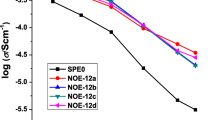Abstract
Aminoalkylsilanes with oligo(ethylene oxide) units were designed and synthesized as multifunctional electrolyte additives for lithium-ion batteries. The chemical structures were fully characterized by nuclear magnetic resonance (NMR) spectroscopy and their thermal properties, viscosities, electrochemical windows, and ionic conductivities were systematically measured. With adding one of these compounds (1 vol. %, DSC3N1) in the baseline electrolyte 1.0 M LiPF6 in EC: DEC (1:1, in volume), Li/LiCoO2 half cell tests showed an improved cyclability after 100 cycles and improved rate capability at 5C rate condition. Electrochemical impedance spectroscopy (EIS), X-ray photoelectron spectroscopy (XPS), and energy dispersive spectroscopic (EDS) analysis confirmed the acid scavenging function and film forming capability of DSC3N1. These results demonstrated that the multifunctional organosilicon compounds have considerable potential as additives for use in lithium-ion batteries.
Similar content being viewed by others
References
Etacheri V, Marom R, Elazari R, Salitra G, Aurbach D. Challenges in the development of advanced li-ion batteries: A review. Energy Environ Sci, 2011, 4: 3243–3262
Xu K, Nonaqueous liquid electrolytes for lithium-based rechargeable batteries. Chem Rev, 2004, 104: 4303–4417
Zhang SS. A review on electrolyte additives for lithium-ion batteries. J Power Sources, 2011, 162: 1379–1394
Shim EG, Nam TH, Kim HS, Moon SI. Effects of functional electrolyte additives for Li-ion batteries. J Power Sources, 2007, 172: 901–907
Wang X, Yasukawa E, Kasuya S. Nonflammable trimethyl phosphate solvent-containing electrolytes for lithium-ion batteries: I. Fundamental properties. J Electrochem Soc, 2001, 148: A1058–A1065
Xu MQ, Zhou L, Hao LS, Xing LD, Li WS, Lucht BT. Investigation and application of lithium difluoro(oxalate)borate (LiDFOB) as additive to improve the thermal stability of electrolyte for lithium-ion batteries. J Power Sources, 2011, 196: 6794–6801
Moshurchak LM, Buhrmester C, Wang RL, Dahn JR. Comparative studies of three redox shuttle molecule classes for overcharge protection of LiFePO4-based Li-ion cells. Electrochim Acta, 2007, 52: 3779–3784
Yang L, Lucht BL. Inhibition of electrolyte oxidation in lithium ion batteries with electrolyte additives. Electrochem Solid State Lett, 2009, 12: A229–A231
Rossib NAA, West R. Silicon-containing liquid polymer electrolytes for application in lithium ion batteries. Polym Int, 2009, 58: 267–277
Tse KY, Zhang LZ, Baker SE, Nichols BM, West R, Hamers RJ. Vertically aligned carbon nanofibers coupled with organosilicon electrolytes: Electrical properties of a high-stability nanostructured electrochemical interface. Chem Mater, 2007, 19: 5734–5741
Weng W, Zhang ZC, Lu J, Amine K. A disiloxane-functionaized phosphonium-based ionic liquid as electrolyte for lithium-ion batteries. Chem Commun, 2011, 47: 11969–11971
Zhang LZ, Zhang ZC, Harring S, Straughan M, Butorac M, Chen ZH, Lyons LJ, Amine K, West R. Highly conductive trimethylsilyl oligo(ethylene oxide) electrolytes for energy storage applications. J Mater Chem, 2008, 18: 3713–3717
Zhang LZ, Lyons L, Newhouse J, Zhang ZC, Straughan M, Chen ZH, Amine K, Hamers RJ, West R. Synthesis and characterization of alkylsilane ethers with oligo(ethylene oxide) substituents for safe electrolytes in lithium-ion batteries. J Mater Chem, 2010, 20: 8224–8226
Amine K, Wang QZ, Vissersa DR, Zhang ZC, Rossib NAA, West R. Novel silane compounds as electrolyte solvents for Li-ion batteries. Electrochem Commun, 2006, 8: 429–433
Xia Q, Wang B, Wu YP, Luo HJ, van Ree T. Phenyl tris-2-methoxydiethoxy silane as an additive to PC-based electrolytes for lithium-ion batteries. J Power Sources, 2008, 180: 602–606
Takechi K, Shiga T. Nonaqueous electrolytic solution for battery and nonaqueous electrolytic solution battery. US Patent 6235431, 2001
Zhang HP, Xia Q, Wang B, Yang LC, Wu YP, Sun DL, Gan CL, Luo HJ, Bebeda AW, van Ree T. Vinyl-Tris-(methoxydiethoxy)silane as an effective and ecofriendly flame retardant for electrolytes in lithium ion batteries. Electrochem Commun, 2009, 11: 526–529
Walkowiak M, Waszak D, Schroeder G, Gierczyk B. Polyether-functionalized disiloxanes as new film-forming electrolyte additive for Li-ion cells with graphitic anodes. Electrochem Commun, 2008, 10: 1676–1679
Takechi K, Koiwai A. Nonaqueous electrolytic solution for battery and nonaqueous electrolytic solution battery. US Patent 6077628, 2000
Markovsky B, Nimberger A, Talyosef Y, Rodkin A, Belostotskii AM, Salitra G, Aurbach D, Kim HJ. On the influence of additives in electrolyte solutions on the electrochemical behavior of carbon/ LiCoO2 cells at elevated temperatures. J Power Sources, 2004, 136: 296–302
Takeuchi T, Kyuna T, Morimoto H, Tobishima S. Influence of surface modification of LiCoO2 by organic compounds on electrochemical and thermal properties of Li/LiCoO2rechargeable cells. J Power Sources, 2011, 196: 2790–2801
Wang E, Ofer D, Bowden W, Iltchev N, Moses R, Brandt K. Stability of lithium ion spinel cells. III. Improved life of charged cells. J Electrochem Soc, 2000, 147: 4023–4028
Zhao Y, Xia D, Li Y, Yu C. Investigation of High-rate spherical LiCoO2 with mesoporous structure via self-assembly in microemulsion. Electrochem Solid State Lett, 2008, 11: A30–A33, and references therein
Baek B, Jung C. Enhancement of the Li+ ion transfer reaction at the LiCoO2 interface by 1,3,5-trifluorobenzene. Electrochim Acta, 2010, 55: 3307–3311
Zhuang QC, Xu JM, Fan XY, Dong QF, Jiang YX, Huang L, Sun SG. An electrochemical impedance spectroscopic study of the electronic and ionic transport properties of LiCoO2 cathode. Chin Sci Bull, 2007, 52: 1187–1195
Takanashi Y, Orikasa Y, Mogi M, Oishi M, Murayama H, Sato K, Yamashige H, Takamatsu D, Fujimoto T, Tanida H, Arai H, Ohta T, Matsubara E, Uchimoto Y, Ogumi Z. Thickness estimation of interface films formed on Li1−xCoO2 electrodes by hard X-ray photoelectron spectroscopy. J Power Sources, 2011, 196: 10679–10685
Author information
Authors and Affiliations
Corresponding author
Rights and permissions
About this article
Cite this article
Wang, J., Luo, H., Mai, Y. et al. Synthesis of aminoalkylsilanes with oligo(ethylene oxide) unit as multifunctional electrolyte additives for lithium-ion batteries. Sci. China Chem. 56, 739–745 (2013). https://doi.org/10.1007/s11426-013-4861-5
Received:
Accepted:
Published:
Issue Date:
DOI: https://doi.org/10.1007/s11426-013-4861-5




